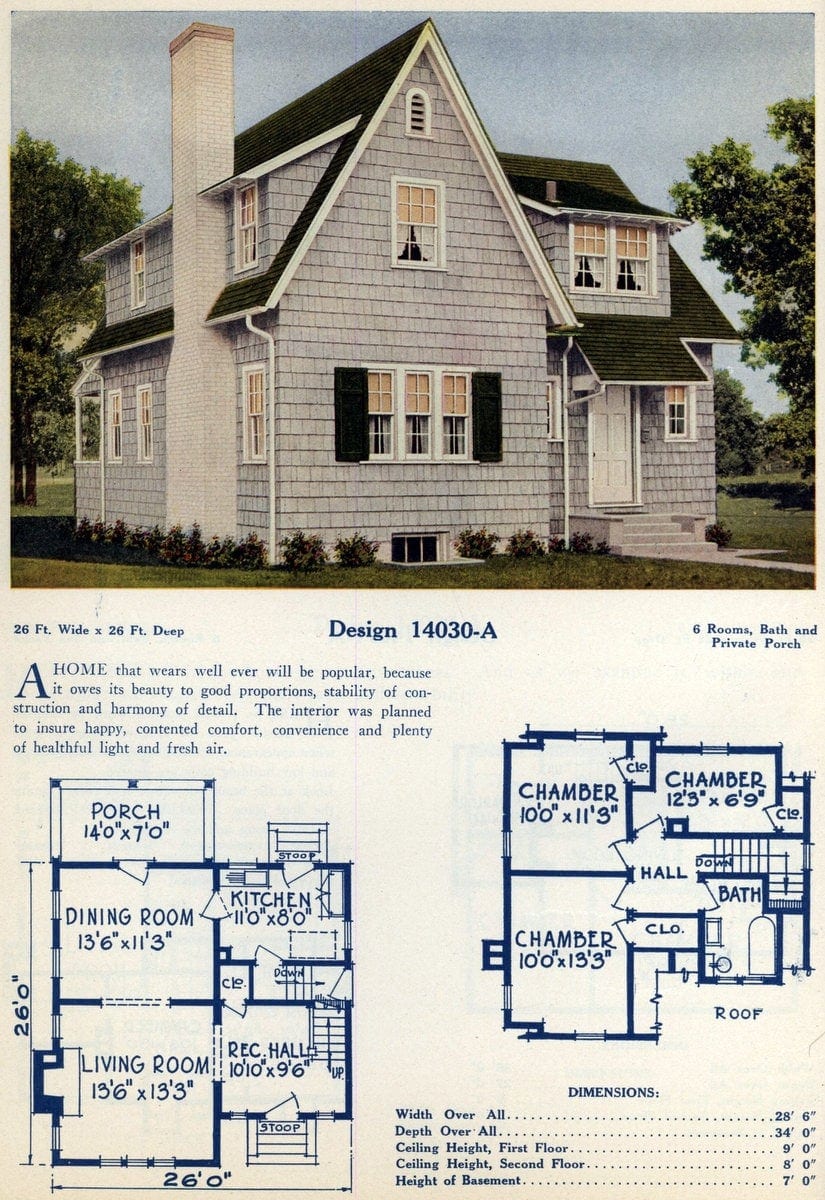1920s house plans: Practical, stylish & timeless designs
Straightforward floor plans & architectural diversity
At the heart of 1920s house plans were simplicity and livability. Many of these designs featured straightforward floorplans with clear divisions between living spaces. Two-story homes were especially popular, offering compact footprints while maximizing indoor space. Kitchens often included built-in cabinets for improved organization, and living rooms were designed to be central gathering places. Bedrooms tended to be modest in size but strategically placed to provide privacy, while porches and side entrances became staples for both aesthetics and practicality.

The variety of styles from the 1920s also reflects the architectural diversity of the period. American Colonial and Dutch Colonial homes were widespread, showcasing symmetrical designs, steep gabled roofs, and charming dormer windows. Mission-style homes, with their clean stucco exteriors and arched doorways, brought a touch of Spanish influence to suburban neighborhoods. Meanwhile, smaller, cottage-like designs offered an option for homeowners who valued simplicity and affordability.
1920s house plans that that were built to last
Many of these homes were built to stand the test of time, and are still around today thanks to their smart, sturdy design. What makes them so appealing even now is how they blend style and practicality in a way that just works. Whether you’re drawn to the cozy charm of a sweet little retro bungalow or the classic elegance of a Colonial, there’s something about these 1920s homes that still feels right at home today.
Below, we’ve gathered a remarkable collection of original 1920s house plans for you to explore. These gorgeous vintage home designs and their floor plans from the 1920s are as authentic as they get. They’re not redrawn, re-envisioned, renovated or remodeled — they are the original house designs from the mid-twenties, as they were presented to prospective buyers.
These house plans from the 1920s are a fascinating look at how families of the past built homes that balanced comfort, style and practicality. Take a look and discover the kind of home that might have been perfect for your family a hundred years ago — or maybe even today.
MORE: These popular 1930s home styles & floor plans had classic and enduring charm
About these old house plans from the 1920s
We offer this new book of home designs for the purpose of assisting those desiring to build a home of their own or to improve their present one.
These homes are in American Colonial, New England, English Colonial, Dutch Colonial, English Manor, Italian, Spanish, or Mission styles, assuring a wide choice in design as well as in size and materials.
The homes illustrated are of the most modern design and have a permanent appeal. Nothing freakish, flashy nor faddish has been included. They were selected on a conservative basis, which at the same time permitted an adequate variety to express one’s individual taste. As a result, they are not of a fly-by-night popularity, but will have a lasting beauty and resale value.
1920s house plans: Designs and basic floorplans for 74 houses
A popular plan for a 3-bedroom vintage house
This attractive home is out of the ordinary because it emphasizes individuality. It is designed along simple and practical lines with careful considerations for economy in construction. The downstairs bedroom is desired by many buyers and allows for the two upstairs bedrooms to be larger than most. This is a very popular choice for those wanting a small home for a moderate cost.

1920s version of a tiny home – The Sunbeam

The perfectly square Courtney home: Vintage 2-story design
This six-room, plus bathroom house plan provides the largest amount of room at the lowest cost. Modern conveniences such as a built-in kitchen cabinet, medicine cabinet, telephone cabinet, linen cabinet, and adjustable closet features are shown.

MORE: See some charming & classic All-American suburban houses from 1919
Vintage 1920s Dutch Colonial house plan

Cronhardt 7-room Dutch Colonial house plan
The Cronhardt home is pure in style and practical to build. Seven large rooms, including four bedrooms, make it particularly suitable for a large family. There is a provision for the installation of a Murphy Bed in the dining room closet.

Seven-room barn-style Colonial with a covered side porch

The Calvin’s vintage 2-story, 6-room home design
A home of plain lines but ample dignity. Adjustable closet fixtures, a telephone cabinet, and a mailbox are some of the conveniences with which it is equipped. This home is an economical choice to build.

Classic vintage home style: The White House
This regal home is reminiscent of a house that would have been built in the late 1700s, from the inside and out. As you examine it, you cannot deny the taste and sensibility of this simple yet stately manor.

A cute Craftman-style ’20s house floorplan

Sweet and small 1920s 3-bedroom home

Floorplan for a 6-room house with a sun parlor
The treatment of the roof lines in The Crandall house plan makes this a house of excellent proportions and very popular with discrimination builders.

Plan for a 6-room-home with private porch

The Carroll old-fashioned house with dining alcove
Not only does this three-bedroom home feature a modern eat-in kitchen, but one bedroom is on the first floor, giving you the space to have two large bedrooms upstairs.

6-room home with a private backyard porch
This charming floor plan will always be a popular choice and owes its beauty to its good proportions, stability of construction, and harmony of detail. The interior, complete with an extra rec hall, was planned to ensure happy, contented comfort, convenience, and plenty of healthful light and fresh air.

An old-fashioned house with the perfect porch for a swing

5-room Cape Cod home with split bedrooms
The Cheltenham has a multi-colored roof of asphalt shingles on the outside as well as a built-in mailbox, delivery receptacle, kitchen cabinet, medicine cabinet, telephone cabinet, and Murphy Bed on the inside. These are just some of the conveniences with which this Cape Cod home is equipped, which makes it a very modern bungalow.

3-bedroom modernized 1920s Colonial-style home

English-style design for a vintage 20s home
With two bedrooms up and one bedroom down, this home is a dwelling that appeals to the eye and to the pocketbook. Its simple architecture makes it economical to build. The thatched roof lends the necessary individual touch.

Craftsman-like 1920s two-story house plan

ALSO SEE: What is a Craftsman house? See exteriors of more than 70 classic Stickley-style homes
Beautiful 6-room New England Colonial house plan
The Cortland is a New England Colonial Home of exceptional charm. The colors used are not only appealing but also restful and will actually mellow with age. Asbestos shingles are used for the room.

Sterling – a small vintage 1920s house

1920s house plan with 6 rooms, a bay window and a large sun parlor

Capitol English design home plan (1920s)

Mayflower design 1920s 4-bedroom semi-bungalow

Victoria 2-story colonial house plan (1920s)

MORE: 40 classic vintage stencil designs you can download & use
Vintage 1920s house plan – Liberty Homes Senator design

Small 2 bedroom 1 bath vintage home design

A Craftsman-inspired vintage 1920s home plan with brick porch

One-story old-fashioned bungalow with wood shingle siding
The “Coburn” is an attractive bungalow that should prove to be exceptionally economical to build. Asbestos shingles are used on the roof.

6-room farmhouse house design with attached sunroom

DON’T MISS THIS: 1940s house plans: These vintage starter home designs were small but beautiful
Vintage 20s small shingled home floorplan
The Cheney is a small, two-bedroom home with the option of a basement. When ordering this floor plan, please specify if you would like to include the basement for extra space or if you are happy with just the main floor.

ALSO SEE: Antique kitchen ranges from the ’20s & ’30s
Bungalow-style 2-story vintage house plan

Old-fashioned 1920s 4-bedroom single-level home plan
The Chipley is a petite bungalow designed for small families. This home includes a Murphy Bed in the living room, a dressing room, and a beautiful front porch. The plan can be built with or without a basement.

7-room, 4-bedroom semi-bungalow with an adorable front porch

The Carver small house with 1 bedroom
This cute little one-bedroom house gives you the choice of having a basement or going without one. It is perfect for a single person or a newly married couple. Includes a Murphy Bed in the living room for guests!

1920s Craftsman-style house with wide shingled porch

6-room family home with a sleeping porch
This two-story, three-bedroom home is built from the inside out — more for comfort than looks — but with such a pleasing exterior no one would believe that is true. This adorable house includes a garage, a sun parlor, and a hard-to-find second-floor sleeping porch.

Perfectly balanced house with a porch and second-floor deck

Old-fashioned house with 3 bedrooms and a sunroom
This charming, individual, English home is especially well suited for a suburban district or for a city residential section. Such houses as these are not extreme or faddish; their distinctiveness is merely a matter of better architecture than is usually found in small homes.

A simple, American-designed home for a small family

Old-fashioned house with 6 rooms and a bay window
This adorable house comes complete with a gambrel roof, three bedrooms, a bathroom upstairs, a sun parlor and a living room adorned with the perfect bay window for watching everything going on outside.

Small and sweet 5-room vintage home with sunroom

A dignified 6-room residence with a grand entrance

Charming two-bedroom house plan with a sun parlor
This is just a well-planned home of unusual merit. The perfect home to build when appearances, convenient room arrangements, and low building costs were desired. Note the large, well-lit, cheerful rooms and the big closets. Then imagine yourself sitting on that sun porch as you start or end your day.

A 1920s shingled starter home floor plan

The Cariola 1920-style stone-look home design
This house looks like it is built with stone, but it is really created in a beautiful pattern with cinder blocks and stucco. The upstairs features three large bedrooms and a deck, while the downstairs shows off with an enclosed porch and a second bathroom.

A Craftsman-style home plan with a sun parlor

Dramatic 1920s 3-bedroom house plan with 2 bathrooms
The Crockett is truly a unique find with an irresistible front, culminating in the artistic face brick entrance, matched with stucco sides. Such features as a butler’s pantry and a half bathroom off the hall make the downstairs arrangement perfect. The spaciousness of the bedrooms and bathroom upstairs should be noticed.

ALSO SEE: Antique iceboxes: What they were & how they worked their magic (1850s-1930s)
4-room shingled bungalow with breakfast nook

7-room stucco Spanish-style house plan
For The Camarillo, the picture tells the story. The beautiful exterior is accomplished by the use of stucco applied to hollow tile in combination with different shades of tile for the roof. The interior is planned with all of the conveniences necessary to modern homes. Do not overlook the garage. A Murphy Bed, if desired, can be arranged in the library on the first floor.

The Commodore steep-roofed vintage 1920s house plan
This English-style stucco home would add beauty to the choicest suburbs and make your family proud. Complete with multiple closets in two of the three bedrooms. The room arrangement is superb, with the dining room and living room being two distinct units.

6-room Chamberlin floorplan with 2 bathrooms and a sunroom

Quaint 5-room bungalow with a porch
This cute house is neat, attractive, and well planned with five rooms and a bath. Suitable for any location. All rooms are large and well-lit. Large closets are conveniently arranged.
The broad front porch, a spacious living room with a cheerful mantel, and the convenience offered by the general arrangement of rooms place this home in a class by itself. This type of design is a mark of progress in homebuilding.

Small 1920s home plan with 2 bedrooms

Rockwood 1920s 2-story house plan

Very small vintage 1920s house plan – The Betsy Ross

Vintage 20s Delaware small house floorplan

1920s house plan – Liberty Homes National design
The National is made in two sizes, plan A size (24×36) with 3 splendid bedrooms, living room, dining room, kitchen, bath, closets and porch. Plan B size (24×30) has living room, dining room, kitchen, two bedrooms, bath, closets and porch.

Vintage Sheridan popular 1920s house plan

A beautiful ’20s English-style brick house design
The Cantwell delivers two bedrooms, a sewing room, and an extra alcove off the biggest bedroom that could be used for a nursery room or library. The two front gables give individuality without eccentricity to the exterior.
The built-in seat and bookcases in the nook, and a built-in linen chest in the sewing room are conveniences of the interior. Stable construction, attractive interior arrangement, and a distinctive architectural style mark the “Cantwell.”

The Chadron shines with 7 rooms and bay window

3-bedroom manor-style vintage house plan
The Charenton offers all the conveniences. Note the Murphy Bed option in the living room, dining nook, dumbwaiter, and space-saving closets. The exterior is beautifully designed in face brick with a green tile roof.

Cardiff 2-story vintage twenties house plan with tile accents

Vintage plan for large single-story residence
One of the biggest one-story homes you will find, the Carstairs home has the most unique roof line and large veranda. Inside, you will find two big bedrooms, a large dining room, and one of the biggest living rooms you will come across, which includes a space for a Murphy Bed. This is the perfect home for a young couple or small family. You can build it with or without a basement if you desire even more space.

ALSO SEE: Antique secretary desks: See 30 examples of fancy & functional furniture
Red brick makes The Crowder home even more majestic

Classic shingled 6-room brown beauty
This home is planned on simple yet effective lines that ensure it is moderate in building cost and pleasing in exterior appearance. It is a very popular design that is especially suited for almost any small or medium-sized family, any locality, and any location.

The Chili 1920s home design had an impressive facade

The simple 2-story 6-room Cambridge home
This house is a beautiful and pure example of the Colonial style of architecture. Its simple designs and three large bedrooms will prove to be a home that will satisfy for years, and, as a bonus, it is equipped with all modern conveniences.

Circyl house with a built-in ironing board in the kitchen
ALSO SEE: How people used vintage washboards, wringers & other old-fashioned laundry equipment years ago

Cuyler home with flower boxes and a sunroom
The outside walls are made of brick, while the interior is planned with all modern utilities such as adjustable closet fixtures, a mailbox, a telephone cabinet, a kitchen cabinet, bookcases, and a fireplace.

The Crosby mixes the beauty of a white house with a green roof, green shutters and striped green awnings

A uniquely-designed vintage house plan concept
The Coburg home is a 6-room, 3-bedroom home that looks so different on the outside that all your friends will want to come check out the inside. The large bedrooms are big enough for your whole family. Available with or without a basement.

The 5-room Candor home design mixes beauty and excellence

The Coyghem 3-bedroom vintage house with solarium
This Dutch Colonial style carried out in face brick proves to be very effective, as shown here. By placing a pergola at one end and the solarium at the other, the architect has achieved perfect balance.
You can visualize the effect of the combined living room and solarium from the floor plan, and you may rest assured that it is delightful. Also, note the large chamber with a fireplace and door opening to the upper deck.

DON’T MISS: Need vintage home restoration inspiration? See 60 authentic tile patterns from the ’20s
Frm the 1920s: Notes on home architecture
One of the first problems that confronts the prospective home builder is the selection of the style of architecture for his new home.
New England Colonial, Dutch Colonial, Old and Modern English, American, Spanish and Italian all prove upon investigation to have practical advantages and undisputed charm. How then does the home builder choose?
Certainly, not all types of houses will appeal to him, but undoubtedly there will be more than one type that will catch his fancy. It would help, in making the final choice, to keep the following points in mind.

First, waive if possible all momentary attractions and think of how the home will appear to you year after year. Will it wear well?
Second, is this particular form of interior arrangement suited to your tastes and requirements? Architectural style determines the interior as well as the exterior.
MORE: 7 popular new home styles of the 1920s
Third, can this home be executed in materials that are available? It is expensive to send far away for large quantities of building supplies.
Fourth, will this kind of a home look best in the setting that has been chosen and will it harmonize with the neighboring houses?
Fifth, can you do justice to this style of architecture with your appropriation? Some types run into much more money than others because of the more elaborate principles upon which they are conceived.
Sixth, has this style of architecture a general appeal? Will the resale value be high?
Time spent thinking on this subject cannot help but mean saving money and insurance against regret. Mistakes are costly, and alterations are expensive and inconvenient. It is only fair to yourself to look into the subject of home architecture to know something about the principles upon which your home is going to be built.

From the 1920s: Home features and other considerations when building
New features: Delivery receptacles, built-in mailboxes, built-in telephone cabinets, kitchen ventilators, bathroom wall heaters, laundry dryers and other new features can be economically installed in your new home.
Space savers: Disappearing stairways, disappearing beds, space-saving closet fixtures, built-in ironing boards and built-in furniture save considerable space, hence greatly reduce building costs.
Labor-saving conveniences: Model kitchens, charming breakfast nooks, built-in furniture, dumb waiters and other conveniences can be incorporated into any design to suit the builder.

MORE: Antique kitchen ranges from the ’20s & ’30s
In this day and age when the inventive faculty is taxed to the utmost and the past has been tapped thoroughly, things distinctive are hard to find.
Think not only of today but consider the future when selecting the plan for your new home. Not many of us build over one or two homes for ourselves; hence, we should acquaint ourselves with the latest improvements in home building and house arrangement and equipment.

A home is an investment for one thing, and the home builder should never forget it. He saves the money that would go for rent and pays it on his home which protects his family. People who are alert and ready to act can almost always find ways of financing the erection of their own homes.
An exceptionally successful builder of moderately priced houses was recently asked what features of construction or equipment he considered the most important for the quick sale of a house.
Without hesitation, he answered: “Good hardware at the front door, adequate heating equipment, and above all a tiled bathroom.”
That prime requisite of the American, sunlight in abundance and architectural beauty, must be filled in order for any type of architecture to survive through the years.
The symmetrical proportions, the massive construction, and the wide roof projections furnish an air of substantial dignity so much admired. Do not overlook the large cheerful living room, the well-appointed kitchen, and the large well-lighted chambers. A home complete with all the essentials to please the happy family.
NOW SEE: 130 vintage ’50s house plans used to build millions of mid-century homes we still live in today



















